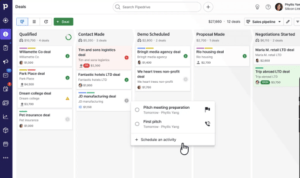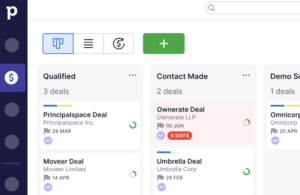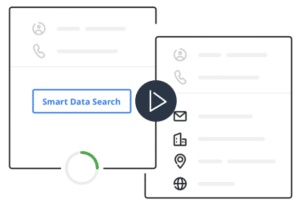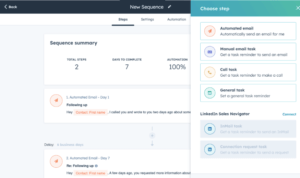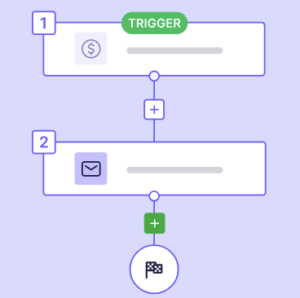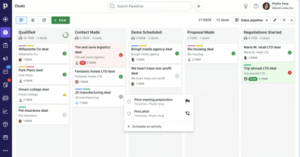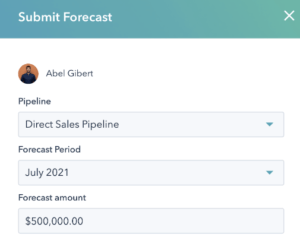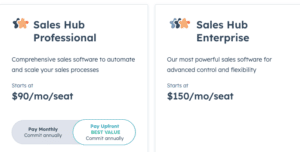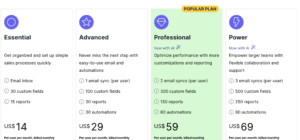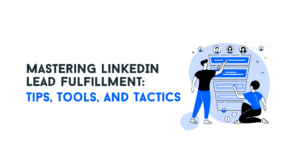A good CRM (customer relationship management) platform is the secret behind smooth sales enablement.
That’s because CRMs today are capable of handling multiple tasks, such as content and lead management, sales process automation, quick contact access, and data analysis.
HubSpot and Pipedrive are two top CRMs that have every sales leader wondering which one is best for their sales reps.
Are you one of them?
Expandi did a head-to-head comparison of Pipedrive vs HubSpot so you can make a well-informed choice of adding a solid CRM platform to your tool stack.
Table of Contents
Pipedrive vs HubSpot – a quick glance
A short breakdown of HubSpot vs Pipedrive CRM before we compare each tool in detail:
| Pipedrive | HubSpot | |
| Affordability | No free plan, but includes affordable plans with advanced inclusions | Free tools are available, but plans are slightly more expensive and complex |
| Customization | Easy to customize, no learning curve | Easy to customize, but some reporting features may require learning |
| Onboarding | No fee | Extra fee |
| Analytics | Easy to interpret and all in one place with a simple dashboard | Deep analytics and reporting data could get scattered |
| Customer support | Chat, email, online community, and phone support for Enterprise users | Chat, email, phone, community, and Academy |
| G2 rating | 4.3/5 (1860 reviews) | 4.4/5 (11k+ reviews) |
What is Pipedrive?
Pipedrive CRM is tailored for salespeople looking to build potent sales pipelines, perform multi-channel engagement, and harness the power of AI into their sales processes.
The platform was launched with SMBs in mind and continues to boost these businesses through smart features and AI.
Pipedrive also offers a wide range of marketing features, such as email automation, contact management, and website visitor tracking.
The best Pipedrive CRM features for effective sales teams
Pipedrive’s customizable CRM solutions help you visualize your entire sales process through a beginner-friendly interface. Let’s discuss its top features that stand out:
1. Stay on top of customer communication
Each salesperson may be interacting with multiple prospects and customers day in and day out. But if you’re not tracking these conversations, building a proper sales-customer relationship can seem impossible.
Pipedrive CRM’s email and communications feature lets you organize interactions with open-and-click message tracking, email automations, and pre-made sales templates, so your team never misses on nurturing key relationships.
2. Automation of repetitive tasks
Are your sales reps spending valuable hours on manual work? Pipedrive lets you automate several mundane sales tasks, so sales reps spend time nurturing and building healthy client relationships.
Pipedrive lets you automate tasks like:
- Sending follow-ups at certain deal stages
- Triggering personalized emails at the right time to move deals further
- Scoring leads to identify high-intent leads
3. Pipeline management
Pipeline management is the crux of a sales CRM, and Pipedrive ensures it is. The platform provides a visually rich and intuitive UI that makes pipeline management a breeze for small to large sales teams.
You can create and customize multiple sales pipelines depending on your unique sales processes. Pipedrive CRM’s pipeline management focuses on activities to drive conversions. For example, it highlights critical deals with colors to catch your attention so you know what to tackle first.
4. CRM reports and insights for sales
Pipedrive’s Insights feature has an intuitive reporting dashboard that helps your sales teams identify winning patterns that lead them to successful deal closures, achieving sales goals, forecasting projected revenue, and more.
Here are some insightful reports you can get your hands on:
- Deal velocity reports
- Team performance reports
- Revenue forecasting
- Winning strategies
- And more!
What is HubSpot?
HubSpot is another multi-functional CRM that has tailored features for sales leaders, marketers, and salespeople. It offers a ton of freemium features like pipeline management, company insights, task management, and reporting,
HubSpot is perfect for businesses of all sizes, be it enterprises or SMBs. Since HubSpot is more than just a CRM and includes features across marketing and operations, it makes it easier to collaborate between sales and other teams for aligned efforts.
The best HubSpot CRM features to tackle sales problems
The HubSpot CRM is well known for its wide set of features and free tools to tackle multiple business problems. Let’s discuss the top ones:
1. Sales Hub
Sales Hub is an exclusive HubSpot CRM software for sales teams. It leverages AI to help sales teams build pipelines and close deals faster.
Its top features include sales engagement tools, reporting and analytics, deal management, payments, and more. These functionalities help streamline sales workflows and empower teams to make data-driven choices, and keep guesswork at bay throughout their sales pipeline.
The best part about HubSpot is that you can easily integrate with its internal and external tools. For example, you can integrate Sales and Marketing Hubs and connect data into one dashboard.
2. Reporting and intuitive dashboards
Sales leaders can track their team’s growth and performance with easily accessible insights. You can choose from over a dozen ready-made reporting templates or customize reports through your own KPIs.
Each report and dashboard can be customized to your liking and included with AI-generated descriptions about relevant topics, such as lead funnels, target audience engagement, and custom objects.
3. CRM templates
Ready-to-use templates are sometimes all busy salespeople need for a quick pick me up. HubSpot offers various templates across sales use cases so your team or sales managers don’t have to start from scratch.
The most valuable templates HubSpot CRM has for sales teams are:
- Email marketing templates for lead nurturing
- Website templates for content management
- Reporting and dashboard templates for tracking sales metrics and sales team performance
- Prospecting activities
- Forecasting and pipelines – deal funnel, deal change history reports, etc.
4. Lead scoring
HubSpot’s lead scoring tool analyzes and scores each lead using data points gathered across customer journeys. It has a zero learning curve and is beginner-friendly, so every new and old sales rep can quickly adapt to its features.
Using this tool, your team can close more deals as they help prioritize deals backed by data and know when to follow up for an optimum closure rate.
Pipedrive vs HubSpot – the ultimate feature and pricing showdown
We’ve seen Pipedrive and HubSpot’s best features, but how exactly do these tools stack up against each other? Let’s discuss.
Contact and lead management
The best sales CRMs must be equipped with accurate contact and lead management. Both HubSpot and Pipedrive have given equal importance to both these accounts.
HubSpot’s free and paid lead management versions let you organize, prioritize, and engage prospects in a centralized platform. Your team can get end-to-end visibility into each lead’s journey across the sales funnel.
The best part about HubSpot’s lead management is the priority given to personalization. For example, it helps the sales team make informed follow-ups by tracking contacts’ histories based on website visits, email interactions, attended meetings, and more.
However, only HubSpot’s Sales Hub Professional and Enterprise plans include the contact management feature, which costs $100/seat monthly and up.
Pipedrive also offers lead and deal management, specifically “Contact or Leads Inbox” which helps you declutter CRM data and improve pre-communication with prospects. With this feature, teams can store incoming leads until they’re ready for qualification, filter, sort, and finally add lead activities to prevent them from turning cold.
Pipedrive’s “Smart Contact Data” is another interesting feature that collects information about your contacts using their email addresses to segment lists.
Verdict: Both tools offer similar contact and lead management capabilities, although Pipedrive is cheaper for SMBs. Also, Pipedrive is exclusive to “lead” management for sales, while HubSpot has a broad spectrum for “contacts” and includes your customers, prospects, inactive subscribers, etc.
Built-in automation
Sales teams can save hours of time with automation. And there’s nothing better than a CRM with built-in automation capabilities.
HubSpot’s sales automation tools are extensive and powerful. Automated follow-ups and email sequences tailor content based on the information extracted from the CRM database so your team never misses out on creating the best prospect relationships.
HubSpot’s Professional paid plan lets you automate up to 300 workflows, while the Enterprise plan lets you automate up to 1000 workflows.
Pipedrive’s CRM automation is equally effective in automating sales workflows and supporting sales reps until deal closure. For example, the tool’s automation features assist with customer retention by letting sales reps schedule campaigns based on pre-made workflow automation templates.
Verdict: Piperdrive’s Professional plan, which costs $49/month, offers automation functions at half the price of HubSpot’s plan.
Reports and analytics
HubSpot has a centralized section for every Hub—sales, Marketing, Customer service, and others. You can also create new dashboards via HubSpot templates. HubSpot offers dozens of customizable reports across use cases and data angles.
However, since HubSpot has a “single source of truth” approach to its dashboards, sales teams, and managers could face a significant learning curve trying to get a hang of its reporting and analytics.
Pipedrive, on the other hand, has an intuitive and user-friendly UI where everything is super accessible and easy to digest.
Each deal is contained within its personal space and can be easily moved around. Sales managers can also quickly detect potential roadblocks and help clear them on the spot. This makes the Pipedrive sales CRM dashboard the ultimate productivity tool for sales teams.
Verdict: Both tools are powerful in terms of analytics, but Pipedrive has a more sorted, easy-to-access dashboard than HubSpot. Meanwhile, HubSpot has the upper hand in the number of customizable reports offered.
Sales forecasting
HubSpot offers sales forecasting as a premium edition under Sales Hub. It gives you a complete view of your sales pipelines to see your team and deals’ quarterly growth. The feature is customizable to each individual’s business needs and is easy to use.
Reps and managers can submit a sales forecast for each quarter or month, which is then circulated across teams and leadership to enable better decision-making.
Pipedrive, too, offers its revenue forecasting tool as a premium feature under the Professional and Enterprise plans. Pipedrive has several forecasting add-ons, such as collecting performance metrics, using historical data to reduce churn, and predicting cash flow so teams can foresee worthy deals and prioritize them.
Verdict: Both tools have the best forecasting abilities to prioritize important deals and maximize revenue. However, Pipedrive’s Revenue forecasting under the Professional plan is slightly cheaper than HubSpot’s.
Plans and pricing
HubSpot has a free plan and complex paid plans. For example, The Sales Hub and Marketing Hub have different pricing plans and inclusions. The free HubSpot tools are only suitable for solopreneurs and fresh startups with a one—or two-person sales team.
HubSpot also has individual plans under Sales Hub Starter and Professional, starting from $15/mo and $90/mo, respectively.
Pipedrive’s pricing plans are very straightforward and uncomplicated compared to HubSpot’s. It doesn’t have separate plans for various features.
Plans start from $14/mo for Essential and go up to $99/mo for Enterprise.
Verdict: Pipedrive’s biggest drawback is the lack of a free plan and free tools compared to HubSpot. However, Pipedrive is still comparatively more affordable than HubSpot for the number of features offered within a single suite.
Wrapping up
If you need a simple CRM that’s tailored for sales use cases and workflows without burning a hole in your pocket, then go for Pipedrive. It has more affordable add-on options and is SMB-friendly.
If you’re looking for an extensive CRM with rich features across domains, go for HubSpot. You can also try the free version to understand if it suits your business needs. It’s more suitable for larger companies needing CRM solutions across multiple areas and handling lots of data.
And if LinkedIn is a part of your sales outreach process and you want to leverage it with an automation tool and a CRM of your choice, then look no further than Expandi.
Expandi helps you generate leads on auto-pilot safely and effortlessly.

